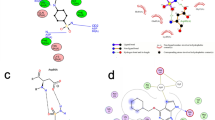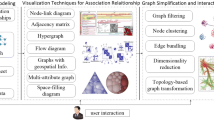Abstract
The π-calculus, in particular its stochastic version the stochastic π-calculus, is a common modeling formalism to concisely describe the chemical reactions occurring in biochemical systems. However, it remains largely unexplored how to transform a biochemical model expressed in the stochastic π-calculus back into a set of meaningful reactions. To this end, we present a two step approach of first translating model states to reaction sets and then visualizing sequences of reaction sets, which are obtained from state trajectories, in terms of reaction networks. Our translation from model states to reaction sets is formally defined and shown to be correct, in the sense that it reflects the states and transitions as they are derived from the continuous time Markov chain-semantics of the stochastic π-calculus. Our visualization concept combines high level measures of network complexity with interactive, table-based network visualizations. It directly reflects the structures introduced in the first step and allows modelers to explore the resulting simulation traces by providing both: an overview of a network’s evolution and a detail inspection on demand.
Similar content being viewed by others
References
Bonchev D, Buck GA (2005) Quantitative measures of network complexity. In: Bonchev D, Rouvray DH (eds) Complexity in chemistry, biology, and ecology. Springer, Berlin, pp 191–235
Byrd D (1999) A scrollbar-based visualization for document navigation. In: DL’99: proceedings of the fourth ACM conference on Digital libraries, pp 122–129
Cardelli L (2004) Brane calculi—interactions of biological membranes. In: Computational methods in systems biology, international conference, CMSB’04. LNCS, pp 257–278
Cardelli L (2008) From processes to ODEs by chemistry. In: (eds) In: IFIP Theoretical Computer Science. Springer, Berlin, pp 261–281
Cardelli L (2008) On process rate semantics. Theor Comput Sci 391(3): 190–215
Cardelli L, Caron E, Gardner P, Kahramanogullari O, Phillips A (2009) A process model of rho GTP-binding proteins. Theor Comput Sci 410(33–34): 3166–3185
Dwyer T, Eades P (2002) Visualising a fund manager flow graph with columns and worms. In IV’02: proceedings of the 6th international conference on information visualisation, pp 147–152
Diehl S, Görg C (2002) Graphs, they are changing—dynamic graph drawing for a sequence of graphs. In: GD’02: proceedings of the 10th international symposium on graph drawing, pp 23–31
Dematté L, Priami C, Romanel A (2008) Modelling and simulation of biological processes in BlenX. Sigmetrics Perform Eval Rev 35(4):32–39, 2008.
Eick SG, Karr AF (2002) Visual scalability. J Comput Graph Stat 11(1): 22–43
Faeder JR, Hlavacek WS, Reischl I, Blinov ML, Metzger H, Redondo A, Wofsy C, Goldstein B (2003) Investigation of early events in fcεri-mediated signaling using a detailed mathematical model. J Immunol 170(7): 3769–3781
Gillespie DT (1977) Exact stochastic simulation of coupled chemical reactions. J Phys Chem 81(25): 2340–2361
Hlavacek WS, Faeder JR, Blinov ML, Perelson AS, Goldstein B (2003) The complexity of complexes in signal transduction. Biotechnol Bioeng 84(7): 783–794
John M, Lhoussaine C, Niehren J (2009) Dynamic compartments in the imperative pi-calculus. In: Degano P, Gorrieri R (eds) Computational methods in systems biology, international conference, CMSB’09. Lecture Notes in Computer Sience, vol 5688. Springer, Berlin, pp 235–250
John M, Lhoussaine C, Niehren J, Uhrmacher AM (2008) The attributed pi calculus. In: (eds) In: Computational methods in systems biology, international conference, CMSB’08 Lecture Notes in Computer Science, vol 5307. Springer, Berlin, pp 83–102
John M, Lhoussaine C, Niehren J, Uhrmacher AM (2010) The attributed pi-calculus with priorities. In: Transactions on computaional systems biology XII. Special issue on modeling methodologies. LNCS (lecture notes in bioinformatics), vol 5945. Springer, Berlin, pp 13–76
John M, Lhoussaine C, Niehren J, Versari C (2011) Biochemical reaction rules with constraints. In: Proceedings of the European symposium on programming, pp 338–357
Kuttler C, Lhoussaine C, Niehren J (2007) A stochastic pi calculus for concurrent objects. In: Anai H, Horimoto K, Kutsia T (eds) Second international conference on algebraic biology. Lecture notes in computer science, vol 4545. pp 232–246
Kuttler C (2006) Simulating bacterial transcription and translation in a stochastic pi-calculus. In: Transactions on computational systems biology 4220/2006:113–149
Leye S, John M, Uhrmacher AM (2010) A flexible architecture for performance experiments with the pi-calculus and its extensions. In: Lawson B (ed) 3rd international ICST conference on simulation tools and techniques, ICST. ICST/IEEE, Malaga, spain
Meyer R, Gorrieri R (2009) On the relationship between π-calculus and finite place/transition petri nets. In: Bravetti M, Zavattaro G (eds) CONCUR—concurrency theory, 20th international conference, vol 5710 in Lecture Notes in Computer Science. Springer, Berlin, pp 463–480
Robin Milner. Communicating and Mobile Systems: the π-calculus. Cambridge University Press, 1999.
Mazemondet O, John M, Maus C, Uhrmacher AM, Rolfs A (2009) Integrating diverse reaction types into stochastic models—a signaling pathway case study in the imperative pi-calculus. In: Rossetti MD, Hill RR, Johansson B, Dunkin A, Ingalls RG (eds) Winter simulation conference, Institute of Electrical and Electronics Engineers, Inc., USA, pp 932–943
Phillips A, Cardelli L (2007) Efficient, correct simulation of biological processes in the stochastic pi-calculus. In: Calder M, Gilmore S (eds) Computational methods in systems biology, international conference, CMSB’07. Lecture Notes in Computer Science, vol 4695. Springer, Berlin, pp 184–199
Phillips A, Cardelli L, Castagna G (2006) A graphical representation for biological processes in the stochastic pi-calculus. Trans Comput Syst Biol 7: 123–152
Phillips A (2009) Some 3D videos of SPiM simulations. http://research.microsoft.com/en-us/projects/spim/default.aspx. Accessed 05 OCT 2009.
Priami C (1995) Stochastic π-calculus. In: Comput J 6: 578–589
Priami C, Regev A, Shapiro EY, Silverman W (2001) Application of a stochastic name-passing calculus to representation and simulation of molecular processes. Inf Process Lett 80(1): 25–31
Rao R, Card SK (1994) The table lens: merging graphical and symbolic representations in an interactive focus+context visualization for tabular information. In: ACM SIGCHI’94: proceedings of the ACM SIGCHI conference on human factors in computing systems, pp 111–117
Regev A (2003) Computational systems biology: a calculus for biomolecular knowledge. PhD thesis, Tel Aviv University, Tel Aviv
Regev A, Panina EM, Silverman W, Cardelli L, Shapiro E (2004) BioAmbients: an abstraction for biological compartments. Theor Comput Sci 325(1): 141–167
Schulz H, John M, Unger A, Schumann H (2008) Visual analysis of bipartite biological networks. In: VCBM’08: proceedings of the eurographics workshop on visual computing for biomedicine, pp 135–142
Tominski C, Abello J, Schumann H (2009) CGV—an interactive graph visualization system. Comput Graph 33(6): 660–678
Tymchyshyn O, Kwiatkowska MZ (2008) Combining intra- and inter-cellular dynamics to investigate intestinal homeostasis. In: Formal methods in systems biology. First international workshop, FMSB 2008, pp 63–76
Versari C, Busi N (2008) Efficient stochastic simulation of biological systems with multiple variable volumes. Electron Notes Theor Comput Sci 194(3): 165–180
Versari C (2007) A core calculus for a comparative analysis of bio-inspired calculi. In: European symposium on programming (ESOP’07), pp 411–425
Author information
Authors and Affiliations
Corresponding author
Additional information
Jim Woodcock
Rights and permissions
About this article
Cite this article
John, M., Schulz, HJ., Schumann, H. et al. Constructing and visualizing chemical reaction networks from pi-calculus models. Form Asp Comp 25, 723–742 (2013). https://doi.org/10.1007/s00165-011-0209-0
Received:
Accepted:
Published:
Issue Date:
DOI: https://doi.org/10.1007/s00165-011-0209-0




